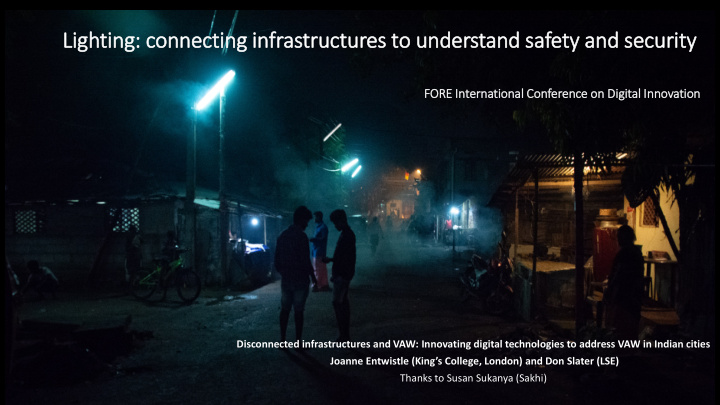



Lighti ting: c : connecting i infrastr tructu tures s to understand s safety ty and security ty FOR ORE Inter ernational C Confer eren ence e on D Digital I Inno novation Disconnected infrastructures and VAW: Innovating digital technologies to address VAW in Indian cities Joanne Entwistle (King’s College, London) and Don Slater (LSE) Thanks to Susan Sukanya (Sakhi)
1. Infrastructures are not gender neutral 2. Broad definition of infrastructure to refer to physical infrastructure, digital infrastructure, social infrastructure 3. Scales of analysis: connecting up international-national-regional to local level knowledge and practice
Connecting lighting and safety… • Lighting is synonymous with safety • BUT Professional/academic knowledge base is poor, sparse, ambiguous and often misused • We don’t have accurate data on ‘how lighting impacts X’ (crime, perception of safety, ‘anti- social behaviour’)
Methodology: • measurement of light levels for both installed lights and ambient lights (from shops, cars, etc) throughout both enclaves; • Photo and video documentation and analysis of light and shadow on a metre by metre basis throughout the enclaves, including documentation of public gathering spaces and pedestrian routes through the neighbourhoods • Observation of night-time practices in public spaces (both men and women, children • Interviews with women in situ about their use of public space and what they think about the lighting. • In Trivandrum some ‘experimentation’ – changing light bulbs in people’s houses to explore light qualities with residents.
Trivandrum, Kerala • Women feel safe in enclave (but very unsafe at home and outside their enclave) • Concerned about the safety of their husbands and sons (alcohol, drugs, fighting, all blamed on outsiders). • Tall mast: • enables visibility of ‘our’ people and ‘outsiders’ • women distinguish brightness from colour rendering (CRI): colour temperature • ‘good light’ = clarity = facial recognition • Safety - we can police ourselves • Lighting infrastructure supports social infrastructure
Ko Kochi, Kerala • Women-light- safety connections reversed • Public space of enclave perceived as dangerous (home and city are less dangerous) • Concerned about men, drugs, alcohol and fighting • Strong division between two ethnic communities who blame the danger on each other. • Community self-policing is not an option. People send girls out of the neighbourhood entirely if possible. • Need to light the few places that women go after dark (public water taps) to publicly support right to be outside • Lighting can’t be divorced from social infrastructure
Other findings • What do we mean by ‘safety’? • Safety – falls into road, ditches, rubbish, collisions with vehicles and people (Trivandrum) • Security – direct forms of violence (Kochi) • Care and maintenance • Repairing lights not just about functionality (safety and security) • Politically symbolic • (low value of value oftheir neighbourhood by the state, marginality, powerlessness as citizens)
Conclusion • Different levels of analysis provide different lens to examine how infrastructures are lived • Standardized measures have to be localized wherever possible • Lighting is not a magic bullet that impacts safety routinely and predictably. To the contrary, our main finding and recommendation is that cities need better social understanding of how both light and safety
Recommend
More recommend